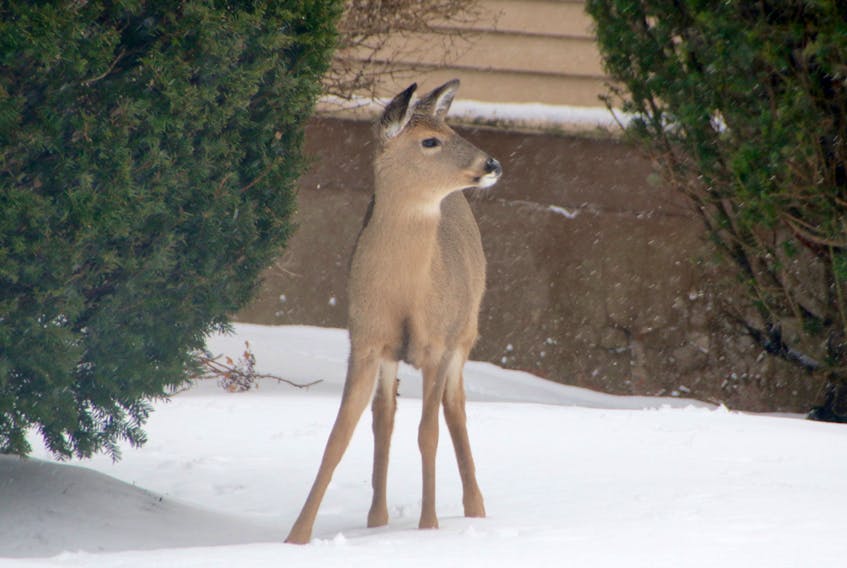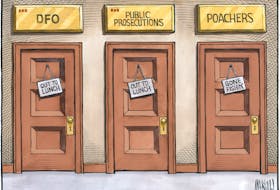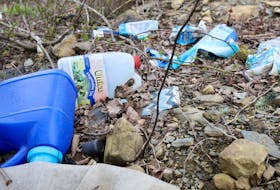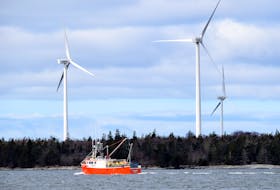TRURO, N.S. – Truro Mayor Bill Mills has issued an invitation to other mayors across the province for a joint meeting aimed at seeking a solution to the urban deer problem.
“I would like to set a meeting date to sit down and discuss a strategy for moving the deer issue forward at the provincial level,” Mills said, in the letter which lays out his frustration at not being able to get assistance from the Department of Natural Resources to the growing population of deer in the urban core.
“The Town of Truro has an urban deer population that has grown to the point that the deer have become a significant nuisance to many of our residents,” the mayor’s letter says. “Given that these are wild animals, we were under the impression that the Department of Natural Resources would play an active role in dealing with our growing herds of urban deer.
“Unfortunately, we have found, like some of you, that the department has only been willing to play a minor role in addressing the deer management issue. We feel that this is something that needs to change and that the Department of Natural Resources should be taking an active role in managing this wildlife resource.”
Mills said he is hoping for a meeting in early April.
Following “extensive consultation” – including through online and written surveys – with town residents last summer, Mills said a total of 1,714 responses were received, 65 per cent were from town residents.
“The results of the survey showed strong opposition against lethal measures being used to control the population, leaving non-lethal methods as the much-preferred option for staff to examine,” the mayor said.
“The difficulty that the Town now faces, which I am sure many for you have faced as well, is determining what non-lethal options are available that will be effective and what the associated costs will be.”
Wildlife management is not an area in which towns have any level of expertise or resources to rely upon, Mills said.
After researching other Canadian jurisdictions that have been facing similar wildlife problems, staff learned that B.C., which deals with both deer and elk, has accepted it as a provincial wildlife issue. And while that province is not dealing directly with the problem, the B.C. government does provide financial support to municipalities to deal with the issue.
Mills said that is far from the response he has been receiving from the Nova Scotia government.
“The recent response from the Minister of Natural Resources to the President of UNSM (Union of Nova Scotia Municipalities) on the deer issue demonstrates the province's intent to stay with the status quo and not provide any additional support,” he said.
Mills said council has determined it is time for impacted municipalities to take “a firm position” with DNR and demand a strategy be put in place to help the towns with the deer problem, or at least provide financial support so the municipalities can deal with it themselves.
Bob Petrie, director of wildlife with the DNR, said he agrees that wildlife control is a provincial responsibility and that his department remains open to further discussion about the issue.
“We have offered the expertise and the advice of our biologist. And, like I’ve said in the past, we have adjusted our regulations to deal with local abundance issues,” Petrie said, of harvest limits that have been changed to reflect Colchester County’s healthy deer population.
But he said the province can’t simply act without knowing the public’s response to a given option for reducing the deer population or provide funding for any potential solutions without knowing what those options are.
“Just throwing money at the problem isn’t going to work,” Petrie said. “I think you have to look at the options.”
And that is something the department is willing to accommodate, he said.
“It may be that the discussion needs to be refreshed and we’re happy to do that,” Petrie said.
“I think the better way to approach that is not approaching from the point of view of financial assistance, because just throwing money at the problem is not necessarily going to work. I think you have to start with what are the options and then once you’ve settled on the options that are projected to have the most benefit. Then you can start the discussion about what it is going to cost and how are those costs distributed.”









